Sautéing technique is more than just tossing vegetables or proteins in a pan—it’s a skill that brings food to life! Whether you’re searing a juicy chicken breast or caramelizing onions for added depth, sautéing technique is a fundamental cooking method every home chef should master. But did you know that this technique, which involves food “jumping” in the pan (hence the name, derived from French “sauter”), has been shaping kitchens for centuries?
Today, we’re breaking down everything you need to know to sauté like a pro. From the science behind the sizzle to actionable tips and recipes, this guide has it all. Time to elevate your cooking!
What Is Sautéing Technique and Why It Matters
Sautéing technique is a dry heat cooking method where ingredients are cooked quickly in a small amount of fat over high heat. It’s prized for its ability to create deep, complex flavors while maintaining a perfect balance of texture—think crispy edges and tender interiors.
What Makes Sautéing Special?
- Quick Cooking: Great for busy weeknights when you need dinner on the table fast.
- Versatility: Works for proteins, veggies, aromatics, or even grains like rice and quinoa.
- Flavor Amplification: Sautéing kickstarts the Maillard reaction, creating that irresistible golden-brown crust.
A Short History Lesson
The origins of sautéing technique trace back to French culinary traditions. The word “sauter” means “to jump,” referring to how ingredients move around the pan. Over time, chefs adopted this method worldwide, valuing its speed, precision, and ability to intensify flavors.
If you’ve been boiling everything or relying on the oven for all your meals, welcome to the world of dynamic, pan-powered cooking!
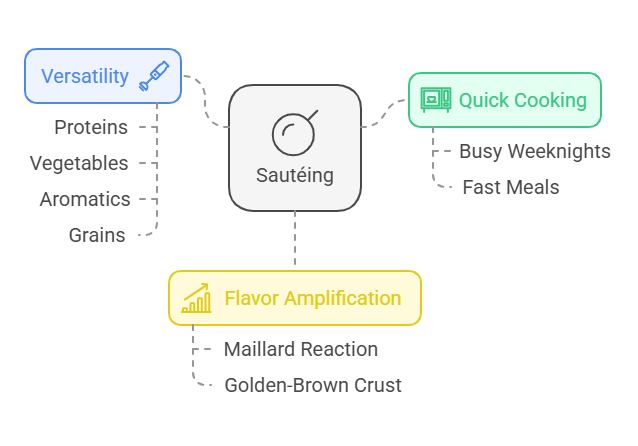
Introduction to the Science of Sautéing Technique
Sautéing technique might seem simple, but there’s fascinating science behind that perfect sizzle.
The Maillard Reaction
At the heart of sautéing technique lies the Maillard reaction—a fancy way of saying, “when heat meets proteins and sugars.” This reaction browns your ingredients and creates layers of flavor that no other method can replicate.
Dry Heat and Its Benefits
Sautéing technique uses dry heat, meaning your food isn’t submerged in liquid. This ensures crispness, intensity, and concentrated flavors—perfect for sautéed mushrooms or seared scallops.
Remember, achieving the perfect sauté isn’t just about tossing things into a pan—it’s about controlling temperature, texture, and timing.
The Equipment Every Sauté Master Needs
Choosing the Right Pan
Not all pans are created equal! For sautéing technique, a wide, flat-bottomed pan with gently sloped sides is essential. Why? It ensures even cooking and allows you to toss ingredients with ease.
- Stainless Steel: Great for heat distribution and browning; ideal for proteins.
- Nonstick: Perfect for delicate foods like eggs or fish (but avoid using too high heat).
- Cast Iron: Retains heat exceptionally well, perfect for heavier dishes.
Must-Have Utensils
- Tongs for flipping chunks of meat.
- Wooden Spoons for stirring liquids or deglazing.
- Fish Spatula for lifting delicate ingredients.
Heat Source Consideration
Gas stoves offer more control, but electric and induction work just fine too. The key is understanding your stovetop heat and preheating your pan properly!
Step-by-Step Technique to Perfect Sautéing
1. Preheat Your Pan
This is non-negotiable. A hot pan ensures your food cooks evenly, and your fat reaches the right temperature for sautéing technique. A simple test? Add a drop of water—it should sizzle and evaporate instantly.
2. Add the Right Fat
Use an oil with a high smoke point (such as vegetable, peanut, or avocado oil). Butter can work but is best combined with oil to prevent burning.
3. Don’t Crowd the Pan
Ever tried to brown mushrooms and ended up steaming them instead? Overcrowding the pan traps too much moisture and prevents that golden crust. Cook in batches if needed—it’s worth it.
4. Keep It Moving
Toss or stir your ingredients frequently, but not obsessively. Too much movement can prevent browning.
5. Adjust Heat as You Go
If the oil starts smoking or your food browns too quickly, lower the heat. If nothing’s happening, crank it up. You’ll learn to read your pan like a pro with practice!
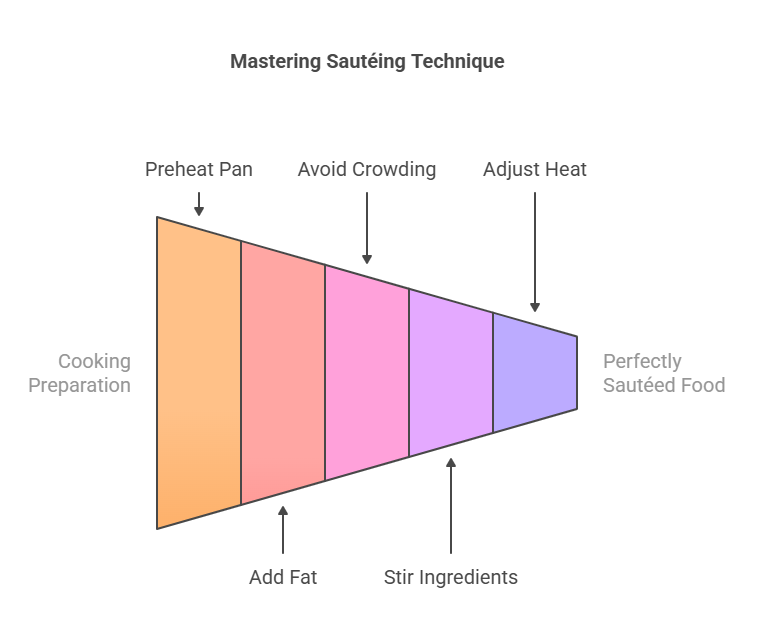
Tips and Tricks for Flawless Sautéing
Layering Flavor With Aromatics
Garlic, onions, shallots—these are your sautéing MVPs. Add them strategically (usually at the start) but be mindful of their cook time to avoid burning.
Managing High-Water Vegetables
Vegetables like zucchini or mushrooms release a lot of water. Sauté these in smaller batches, letting excess moisture evaporate for better caramelization.
Deglazing for Extra Flavor
After sautéing technique proteins or aromatics, deglaze the pan with wine, broth, or vinegar to create a flavorful base for sauces. It’s both easy and impressive!
When to Add Herbs or Citrus
Add fresh herbs and citrus zest in the final seconds to preserve their bright flavors. This little finishing touch can turn a good dish into an outstanding one.
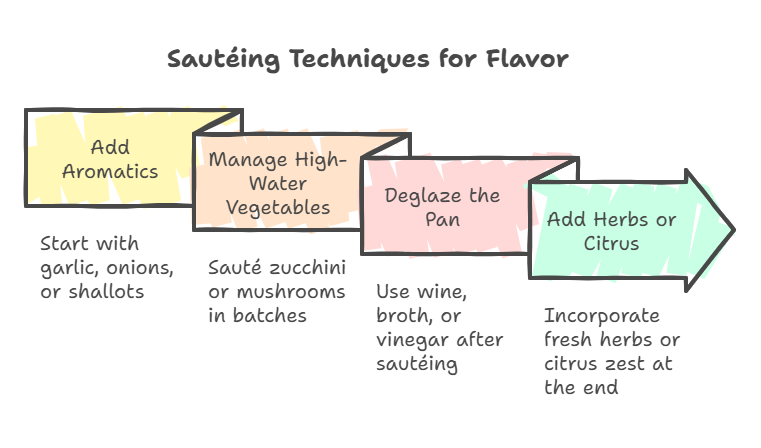
Common Sautéing Mistakes (And How to Avoid Them)
- Overcrowding the Pan: Always allow room for your ingredients to breathe!
- Skipping Ingredient Prep: Mise en place is key. Chop, measure, and organize everything before you start.
- Burning Aromatics: Watch garlic and shallots closely—they burn quickly. Add them toward the end or lower the heat.
- Improper Heat Management: Use medium-high heat for most foods and adjust swiftly as required.
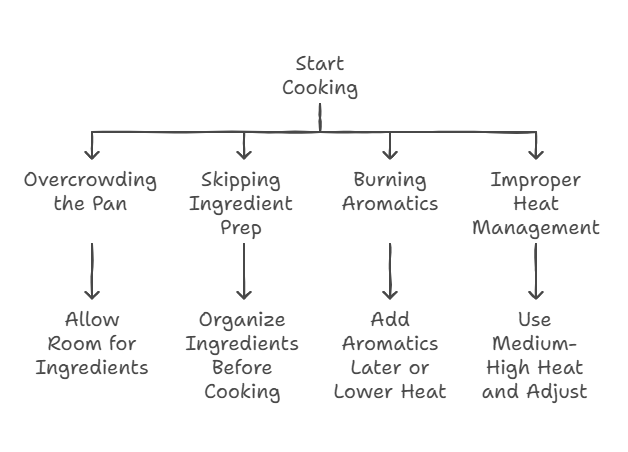
Recipes to Perfect Your Sautéing Skills
Beginner-Friendly
- Sautéed Garlic Green Beans with Lemon Zest
- Bright, fresh, and simple—perfect for first-timers.
- Simple Sautéed Chicken Breast with Herbs
- A weeknight dinner staple.
Intermediate
- Sautéed Shrimp in Garlic Butter Sauce
- Learn to work with proteins while building flavor.
- Caramelized Mushrooms with Thyme and White Wine
- A side dish that could rival the main course.
Advanced
- Sautéed Duck Breast with Cherry-Balsamic Glaze
- If you’re ready to flex some serious culinary muscles, this is it.
Sautéing for Every Skill Level
The beauty of sautéing lies in its scalability—whether you’re a beginner or an experienced cook, it offers endless possibilities. Start small, experiment with different oils or spices, and challenge yourself with more intricate recipes as you grow.
Final Thoughts
Sautéing technique is more than just a cooking method—it’s a skill that opens up a world of flavor and culinary confidence. Remember, mastering it takes practice, patience, and a willingness to experiment. Once you’ve built your sautéing prowess, you’ll find yourself edging closer to becoming the chef you’ve always dreamed of being.
Now it’s your turn—grab your pan, heat it up, and get cooking. Which recipe will you try today? Share your thoughts and sautéing successes in the comments below!
📌 Stay connected with us!
- Follow us on Instagram: @RoastedKitchen25 for daily cooking inspiration.
- Tag us in your creations using #RoastedKitchensaute—we’d love to see what you make!
- Subscribe to our newsletter for exclusive recipes, expert tips, and kitchen hacks straight to your inbox!
Frequently Asked Questions About Sautéing Technique
1. What is sautéing technique, and why is it important?
Sautéing is a quick, dry heat cooking method where ingredients are cooked in a small amount of fat over high heat. It’s essential because it enhances flavor, develops appealing textures, and offers versatility for preparing proteins, vegetables, and grains.
2. What makes the Maillard reaction important in sautéing?
The Maillard reaction occurs when heat causes proteins and natural sugars in food to chemically react, creating a golden-brown crust and rich, savory flavors. It’s the secret to making sautéed dishes taste so delicious.
3. What’s the best type of pan for sautéing technique?
A wide, flat-bottomed pan with sloped sides works best for sautéing. Options include:
- Stainless Steel: Ideal for browning and high-heat cooking.
- Nonstick: Great for delicate foods like eggs or fish but avoid high heat.
- Cast Iron: Retains heat well, perfect for searing heavier ingredients.
4. How do I choose the best oil for sautéing technique?
Use oils with a high smoke point to prevent burning. Good options include:
- Vegetable oil
- Avocado oil
- Peanut oil
You can also combine oil with butter for better flavor, but don’t rely on butter alone at higher temperatures—it burns easily.
5. Why is it important not to overcrowd the pan?
Overcrowding traps steam and prevents your food from browning properly. To ensure even cooking and a golden crust, give your ingredients space and cook in batches if necessary.
6. How do I avoid burning aromatic ingredients like garlic and onions?
Aromatics burn quickly, especially at high heat. Add them early on for flavor but monitor closely, or add them near the end of cooking to avoid burning. Lower the heat as needed.
7. What’s the best way to preheat a pan for sautéing technique?
Heat your pan over medium to medium-high heat for a few minutes. Test by adding a drop of water—it should sizzle immediately and evaporate. This step ensures even cooking and helps prevent food from sticking.
8. How can I caramelize vegetables without making them soggy?
To caramelize vegetables:
- Avoid overcrowding the pan.
- Cook in small batches.
- Use medium-high heat to evaporate moisture quickly, which leads to better browning and avoids sogginess.
9. How do I adjust the heat while sautéing?
Sautéing often requires managing heat. If food browns too quickly or oil starts to smoke, lower the heat. If nothing is happening in the pan, increase the heat. Learning to read your pan takes practice but is essential for perfect results.
10. What are common mistakes in sautéing, and how can I avoid them?
- Skipping ingredient prep: Always use mise en place—prep everything before starting to cook.
- Too much oil: Use just enough to coat the pan lightly.
- Crowding the pan: Cook in batches for even results.
- Improper heat levels: Preheat your pan and adjust heat as you go.
11. Can I deglaze the pan while sautéing?
Absolutely! Deglazing involves adding liquid (like wine, broth, or vinegar) to the hot pan to dissolve food particles stuck at the bottom, creating a flavorful sauce. It’s a great way to enhance your dish.
12. When should I add fresh herbs or citrus zest?
Add fresh herbs or citrus zest at the very end of cooking to preserve their bright flavors and avoid bitterness from overcooking.
13. How can I practice sautéing as a beginner?
Start with simple recipes like sautéed green beans or chicken breast. Focus on mastering the basics—preheating the pan, controlling the heat, and avoiding overcrowding. Gradually move on to more complex recipes as you gain confidence.
14. What’s an easy way to tell if my sautéing is going well?
Look for golden-brown edges and listen for a steady sizzling sound. If no browning occurs, increase the heat. If the food burns or your oil smokes, lower the heat instantly.
15. How is sautéing technique different from frying?
Sautéing uses minimal oil and high heat to cook food quickly. Frying, on the other hand, submerges food in oil and typically requires longer cooking times.
16. Can I sauté on any type of stovetop?
Yes! Sautéing works on gas, electric, and induction stovetops. Gas offers more precision, but with proper technique and attention, you can sauté successfully on any heat source.
Mastering these FAQs will help you sauté with confidence and unlock a world of flavorful dishes!

Hi, I’m Mayaz Ahsan!
As a passionate cook, storyteller, and food enthusiast, I combine my love for travel, farming, reading, and teaching to bring you insightful culinary tips and stories. Welcome to Roasted Kitchen – I’m thrilled to share this journey with you!

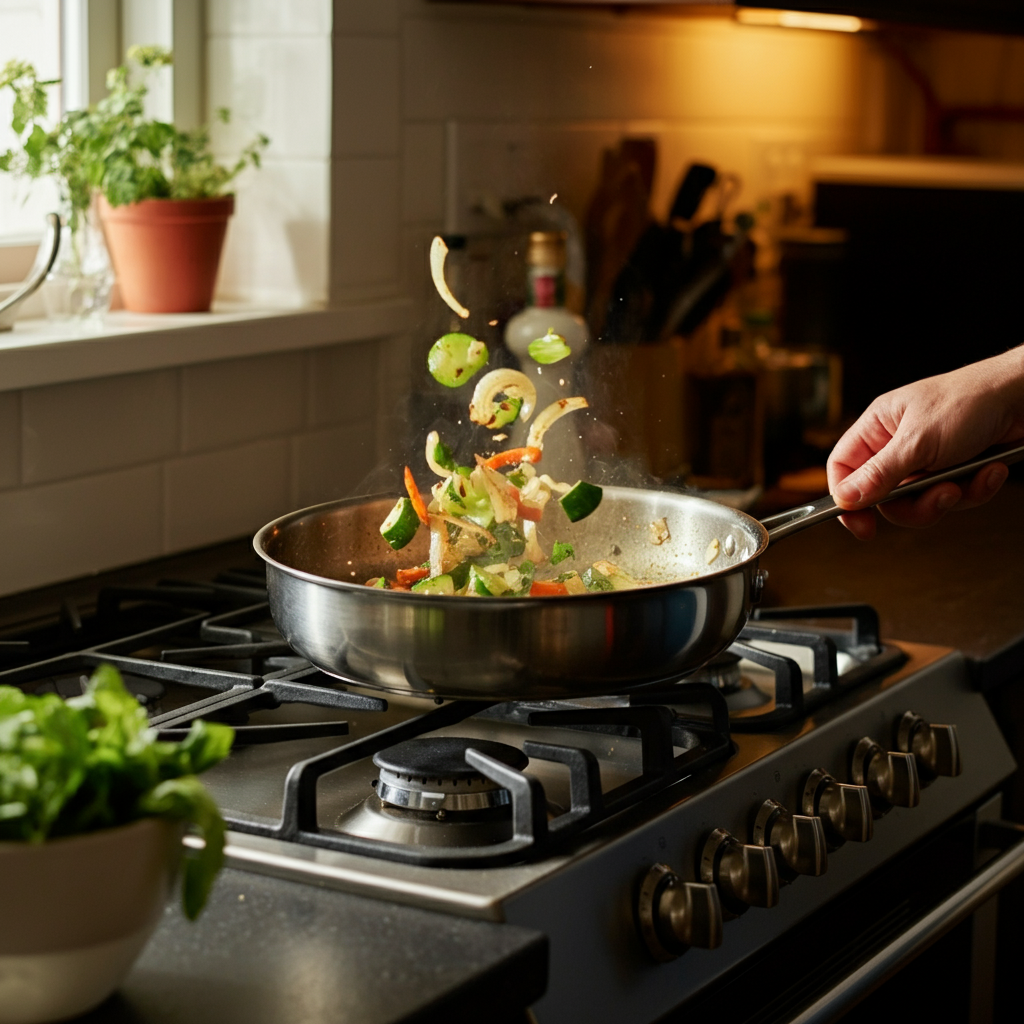








 Subscribe to our free newsletter for tips, tutorials, and insights!
Subscribe to our free newsletter for tips, tutorials, and insights!